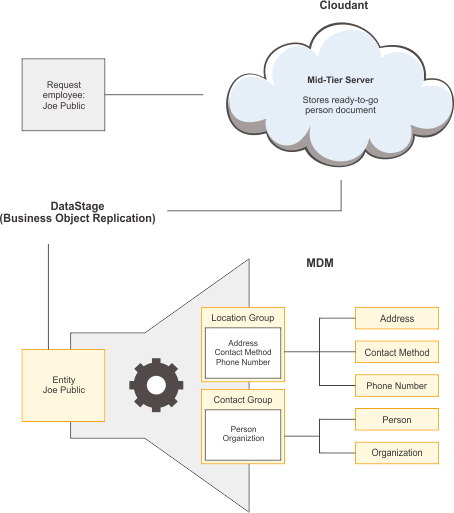Use case and business solution
Bank A manages customer profile and contact details in their on-premises IBM® InfoSphere® Master Data Management system. Now, to better serve their customers, they are developing a mobile application with the ability to view customer checking and credit card balances, and to review customer profile and contact details for accuracy. The mobile application provides read-only access to customer profile details, customers must visit a Bank A branch in order to make changes to profile and contact details if they are incorrect.
The Bank A mobile application is expecting to service a high number of concurrent user requests. Bank A opts to use the MDM and Cloudant® integration sample to support scalability and performance requirements. Bank A also chooses to use the IBM Bluemix platform to speed development time of the mobile application.
The on-premises MDM maintains the system of record. An initial bulk data load from MDM copies read-only JSON documents that contain the business entities (customer records) and stores them in a Cloudant cache. When MDM receives a change (insert or update) request, a JMS message with some of the parameters of the entry is generated and the updates are propagated to the Cloudant cache. (Only Party entities are supported for MDM to Cloudant replication.) Storing the JSON entity documents in the Cloudant cache, rather than replicating the contents of the MDM on-premises SQL data, offers better performance and eliminates the necessity of processing MDM business rules on the cloud.
When customers interact with the mobile application, the application in turn queries for customer information and retrieves the relevant read-only records from Cloudant. Updates to customer data made from the Bank A branch office are sent to bank's on-premises MDM. Updates from MDM are synchronized with Cloudant and become available on the mobile application in near real time.
InfoSphere DataStage® jobs are used to process the business object replication in Cloudant.

The entity, or business object, is built in MDM. The DataStage jobs use read-only MDM APIs to query MDM for a list of customer IDs. The job then iterates over the resulting list and uses MDM REST APIs to create the JSON document directly from MDM. The job then uses both MDM and Cloudant REST APIs to store the JSON document in the cloud.
When updates are made in MDM, the DataStage JMS_listener stage listens for change notifications and parses customer IDs from the notification XML message. The customer document is updated in Cloudant by document key and revision number.